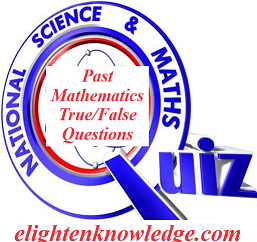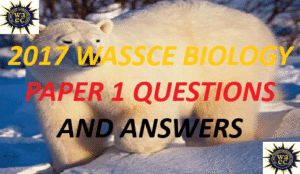ABOUT 53 MATHEMATICS TRUE OR FALSE NSMQ PAST QUESTIONS

ABOUT 53 MATHEMATICS TRUE OR FALSE NSMQ PAST QUESTIONS
- Every triangle has a center of symmetry.
ANSWER: FALSE
- An isosceles triangle has a center of symmetry.
ANSWER: FALSE
- An equilateral triangle has a center of symmetry.
ANSWER: FALSE
- y = 2sinx has a maximum value at x = π.
ANSWER: FALSE
- y = 3cosx has a maximum value at x = π.
ANSWER: FALSE
- y = tanx has a maximum value at x = π.
ANSWER: FALSE
NSMQ PAST QUESTION; CHEMISTRY (02)
NSMQ Past Question; Chemistry (03)
NSMQ Past Question; Chemistry (01)
- 3 > √8
ANSWER: TRUE
- 2√7 > 3√3
ANSWER: TRUE
- 3√5 > 4√3
ANSWER: FALSE
- If the sum of the interior angles of a triangle is 300°, then it is a rectangle.
ANSWER: TRUE
- If 3 + 6 = 10, then 3 x 6 = 15.
ANSWER: TRUE
- If the interior angle of a rectangle measures 120°, then it is a pentagon.
ANSWER: TRUE
- 4a2 + 6ab + 9b2 = (2a + 3b)2
ANSWER: FALSE
- (5a – 2b)2 = 25a2 – 20ab + 4b2
ANSWER: TRUE
- 9a2 + 24ab + 16b2 = (3a + 4b)2
ANSWER: TRUE
- A triangle fits its outline in three positions.
ANSWER: FALSE
- A parallelogram fits its outline in two positions.
ANSWER: TRUE
- A square fits its outline in 4 positions.
ANSWER: FALSE
- The point A(3, 4) is in the solution set of the inequality x2 + y2 > 25.
ANSWER: FALSE
- The point B(-6, 7) is in the solution set of the inequality x2 + y2 < 81
ANSWER: FALSE
- The point C(3, – 5) is in the solution set of the inequality x2 + y2 > 33
ANSWER: TRUE
- Sum of the interior angles of a polygon of n sides is (n + 2)π radians
ANSWER: FALSE
- The interior angle of a polygon of n sides has measure (n – 2)π/n.
ANSWER: FALSE (only when it is equiangular)
- The sum of the exterior angles of any polygon is 2 straight angles.
ANSWER: TRUE
The given equation has no real solution.
- cosx = secx
ANSWER: FALSE (cos2x = 1 has real solutions)
- sinx = – cosecx
ANSWER: TRUE (sin2x = -1 has no real solution)
- tanx = – cotx
ANSWER: TRUE (tan2x = -1 has no real solution)
The pair of equations represent parallel lines.
- y = 3x + 5 and x/(1/3) + y/(-1) = 12
ANSWER: TRUE
- y = -5x + 3 and 5x – y = 3
ANSWER: FALSE
- x/2 + y/3 = 1 and y = 3x/2 + 7
ANSWER: FALSE
- A rectangle can be circumscribed by a circle.
ANSWER: TRUE
- A circle can be inscribed in a rectangle.
ANSWER: FALSE
- A circle can be inscribed in a rhombus.
ANSWER: TRUE
- √(56) is an irrational number
ANSWER: FALSE
[ √(2.56) = 1.6 a rational number]
- π is a rational number.
ANSWER: FALSE
- √(18/8) is a rational number.
ANSWER: TRUE
[18/8) = 9/4) = 3/2 a rational number]
In linear programming,
- the objective function is of the form Ax + By,
ANSWER: TRUE
- the constraints can be quadratic inequalities,
ANSWER: FALSE
- the solution occurs at a corner point of the graphed region.
ANSWER: TRUE
The following quadrilateral has two pairs of adjacent congruent sides.
- Parallelogram
ANSWER: FALSE
- Rhombus
ANSWER: FALSE
- Kite
ANSWER: TRUE
- the inequality x2/4 + y2/6 < 1 describes a region inside a circle.
ANSWER: FALSE
- The inequality x2 + y2 > 16 describes a region outside a circle.
ANSWER: TRUE
- The inequality y2 > x2 describes a region above the line y = x.
ANSWER: FALSE
Determine if the converse of the statement is true or false
- A cube is a hexahedron.
ANSWER: FALSE
- A polygon is a pentagon.
ANSWER: TRUE
- A tetrahedron is a pyramid.
ANSWER: FALSE
- The point A(5, 2) is in the solution set of the inequality 3x – 5y < 8.
ANSWER: TRUE
- The point B(3, -2) is in the solution set of the inequality 5x + 7y > 1.
ANSWER: FALSE
- The point C(-4, -2) is in the solution set of the inequality 3x – 6y < -1.
ANSWER: FALSE
Two triangles are congruent if
- two sides and an angle of one are congruent to any two sides and an angle of the other.
ANSWER: FALSE
- two angles and an included side of one are congruent to the corresponding parts of the other triangle.
ANSWER: TRUE
- two angles and a side opposite to one of the angles are congruent to two angles and a side opposite to the corresponding other angle.
ANSWER: TRUE
- 234 is a rational number.
ANSWER: TRUE
- √(9) is a rational number.
ANSWER: FALSE
- √(18/100) is a rational number
ANSWER: FALSE
The system of equations has a unique solution.
- x + y = 1 and x – y = -1
ANSWER: TRUE
- x + 2y = 1 and x/2 + y/1 = 4
ANSWER: FALSE (parallel lines no intersection)
- x/2 + y/3 = 1 and y = -3x/2 + 3 (same line infinite solutions)
ANSWER: FALSE
- A sequence is exponential if the ratio of successive differences of consecutive terms are the same.
ANSWER: FALSE
- An exponential series has a finite sum to infinity provided the common ratio r is such that | r | < 1. (Read as absolute value of r is less than 1)
ANSWER: TRUE
- An exponential sequence with common ratio r = 1 is also a linear sequence.
ANSWER: TRUE
- In a parallelogram, the diagonals bisect each other and bisect the vertex angles.
ANSWER: FALSE
- In a kite one diagonal bisects its vertex angles and bisects the other diagonal.
ANSWER: TRUE
- In a rhombus, the diagonals bisect each other perpendicularly and are congruent.
ANSWER: FALSE
- The ordered pair (2, 3) is a solution of the inequality 3x – 2y < 1
ANSWER: TRUE
[3(2) – 2(3) = 6 – 6 = 0 < 1, true]
- The ordered pair (3, – 2) is a solution of the inequality 2x + 4y > -2
ANSWER: FALSE
[2(3) + 4(-2) = -2 > -2 false]
- The ordered pair (-2, 2) is a solution of the inequality 2x + 3y < 3
ANSWER: TRUE
[2(-2) + 3(2) = -4 + 6 = 2 < 3, true
d1 and d2 are the lengths of the diagonals of the given quadrilateral.
- The area of a rhombus is ½d1d
ANSWER: TRUE
- The area of a rectangle is ½d1d2.
ANSWER: FALSE
- The area of a kite is ½d1d2.
ANSWER: TRUE
- A triangle has three axes of symmetry.
ANSWER: FALSE
- A square has four axes of symmetry.
ANSWER: TRUE
- A pentagon has five axes of symmetry.
ANSWER: FALSE
The solution set of the inequality (x – 3)(4 – x) < 0 is
- {x: 3 < x < 4}
ANSWER: FALSE
- {x: x < -4, or x > – 3}
ANSWER: FALSE
- {x: x < 3, or x > 4}
ANSWER: TRUE
- x2 – x + 1 is a factor of x3 – 1
ANSWER: FALSE
- x2 + x – 1 is a factor of x3 – 1
ANSWER: FALSE
- x2 – x – 1 is a factor of x3 – 1
ANSWER: FALSE
- The equation y2 = x2 represents 2 perpendicular lines.
ANSWER: TRUE
[ y = ± x, which are perpendicular]
- The equations x + 2y = 5 and 2x + y = 5 represent 2 perpendicular lines.
ANSWER: FALSE
- The equations x/3 + y/4 = 1 and y = 3x/4 + 1 represent 2 perpendicular lines.
ANSWER: TRUE
- 3x4 + 5x2 + 7 is a trinomial.
ANSWER: TRUE
- 2x2 – 3/x2 + 7 is a trinomial.
ANSWER: FALSE
- 3x2y3z is a monomial.
ANSWER: TRUE
- For a reflex angle the cosine is negative.
ANSWER: FALSE
- For a reflex angle the cosine is positive.
ANSWER: FALSE
- For a reflex angle, the sine is negative.
ANSWER: TRUE
NSMQ PAST QUESTION; MATHEMATICS pdf.
In a triangle,
- the point of intersection of the altitudes is the centroid,
ANSWER: FALSE
- the point of intersection of the angle bisectors is the ortho-center,
ANSWER: FALSE
- the point of intersection of the perpendicular bisectors of the sides is in the center.
ANSWER: FALSE
Consider the exponential function y = 2x.
- The domain is the set of all real numbers.
ANSWER: TRUE
- The range is the set of all real numbers.
ANSWER: FALSE
- The point (0, 1) is a member of the function.
ANSWER: TRUE
Consider 2 simultaneous linear equations in x and y
- The equations have at most one solution.
ANSWER: FALSE
- The equations have at least one solution.
ANSWER: FALSE
- The equations may have an infinite number of solutions.
ANSWER: TRUE
- If a triangle has four sides, then the sum of its interior angles is 400°
ANSWER: TRUE
- If 2 × 3 = 8, then 8 ÷ 3 = 5
ANSWER: TRUE
- If the sum of 2 integers is odd, then both integers are odd.
ANSWER: FALSE
The truth set of the equation | x | = – x is
- the null set,
ANSWER: FALSE
- the set {x: x = 0},
ANSWER: FALSE
- the set {x: x < 0}.
ANSWER: FALSE [the truth set is {x: x}]
- sin-1(1/2) = 150
ANSWER: FALSE
- cos-1(-1/2) = 120
ANSWER: TRUE
- tan-1(-1) = 135
ANSWER: FALSE
- 54 < 45
ANSWER: TRUE
(625 < 256 x 4 is true)
- 5-2 < 2-5
ANSWER: FALSE
(1/25 < 1/32 is false)
- (-3)3 < 3-3
ANSWER: TRUE
( -27 < 1/27 is true)
- The interior angle of a regular polygon is an obtuse angle.
ANSWER: FALSE
- The exterior angle of a regular polygon is an acute angle
ANSWER: FALSE
- The sums of the interior angles and the exterior angles of a polygon of n sides is n
ANSWER: TRUE
The implication ‘P implies Q’ is true whenever
- P is true,
ANSWER: FALSE
- exactly one of P, Q is true,
ANSWER: FALSE
- P is false.
ANSWER: TRUE
- The converse of a definition is true.
ANSWER: TRUE
- The converse of a true statement is always true.
ANSWER: FALSE
- The inverse of a true statement is also a true statement.
ANSWER: FALSE
- Multiplying a positive number by a non-negative number gives a positive number.
ANSWER: FALSE
- Multiplying a negative number by a non-negative number gives a negative number.
ANSWER: FALSE
- Multiplying a non-negative number by a non-negative number gives a positive number.
ANSWER: FALSE
- The sequence 1, 22, 33, 44, . . . is an exponential sequence.
ANSWER: FALSE
- The sequence 1, 3, 6, 10, 15, . . . is a linear sequence.
ANSWER: FALSE
- The sequence 1, ½, ¼, 1/6, 1/8, . . . is an exponential sequence.
ANSWER: FALSE
- The domain of the function f(x) = √(4 – x2) is {x: x > 2 or x < – 2}
ANSWER: FALSE
- The domain of the function f(x) = (x – 1)/(x2 + 1) is {x: x ≠ ± 1}
ANSWER: FALSE
- the domain of the function f(x) = √(x2 – 9) is {x: x ≥ 3, or x ≤ -3}.
ANSWER: TRUE
- The range of y = tan-1x is {y: -∞ < y < ∞} (tan inverse of x)
ANSWER: FALSE
- The domain of the function y = cos-1x is {x: 0 < x < 1} (cosine inverse of x)
ANSWER: FALSE
- The range of y = sin-1x is {y: – π/2 ≤ y ≤ π/2} (sine inverse of x)
ANSWER: TRUE
The pair of equations represent perpendicular lines.
- 2x + 3y = 1 and x/2 – y/3 = 5
ANSWER: TRUE
- y = 3x – 5 and x/3 + y/-1 = 9
ANSWER: FALSE
- 2y = 7x + 5 and x/7 – y/2 = 5
ANSWER: FALSE
- (a – 2)(a2 + 2a + 4) = a3 – 8
ANSWER: TRUE
- (x + y)(x2 + xy + y2) = x3 + y3
ANSWER: FALSE
- (2a – 3)(4a2 – 6a + 9) = 8a3 – 27
ANSWER: FALSE
- log4 √8 = 3/2
ANSWER: FALSE
- log3 ∛81 = 3/4
ANSWER: FALSE
- log5 ∜125 = 3/4
ANSWER: TRUE
- The ordered pair (-1, 2) satisfies the inequality x + y < 1.
ANSWER: FALSE
[-1 + 2 = 1 < 1 false]
- The ordered pair (2, – 3) satisfies the inequality 2x + y < 1
ANSWER: FALSE
[2(2) – 3 = 1 < 1 false]
- The ordered pair (3, – 1) satisfies the inequality x + y < 3.
ANSWER: TRUE
[3 – 1 = 2 < 3 true]
- The sum of the interior angles of a decagon is 1400°.
ANSWER: FALSE
- The sum of the interior angles of a septagon is 900°.
ANSWER: TRUE
- The sum of the interior angles of a duo-decagon is 1800°.
ANSWER: TRUE
The given equation of a line is in the slope-intercept form
- 2y = 3x + 7
ANSWER: FALSE
- x/3 + y/5 = 2
ANSWER: FALSE
- y = -2x + 7
ANSWER: TRUE
Consider the function f(x) = log x
- The domain is the set of all real numbers.
ANSWER: FALSE
- The range is the set of all real numbers.
ANSWER: TRUE
- The point (1, 0) lies on the graph of f(x).
ANSWER: TRUE
- The rational number 5/8 is less than the rational number 7/11.
ANSWER: TRUE
- The rational number 7/15 is less than the rational number 8/17.
ANSWER: TRUE
- The rational number 4/7 is less than the rational number 7/13.
ANSWER: FALSE
For a natural number n to be divisible by 18,
- it is necessary that n is divisible by 6,
ANSWER: TRUE
- it is sufficient that n is even and divisible by 9.
ANSWER: TRUE
- it is necessary that n is divisible by 12.
ANSWER: FALSE
Join us on Our WhatsApp platform for more





